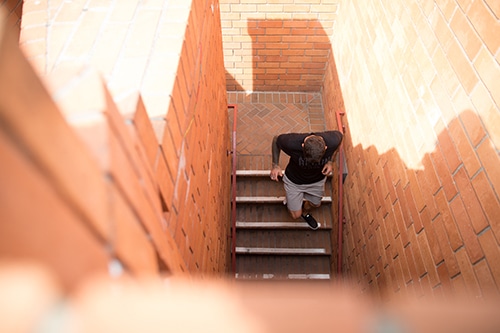The Unexpected Cause of Many Common Running Issues & Injuries

What is anterior dominance? We live in a world where we are sitting at a desk for most of the day, on our phones texting or browsing, or walking from one place to another. The problem with these activities is that they cause us to be in a position that involves excessive hip flexion (bending) and/or knee flexion. When we overuse the front half of our bodies this way, we become anterior dominant.
The Cause of Common Running Issues and Injuries
1. Shortened Hip Flexors
Hip flexion shortens the hip flexors. When hips flexors get shortened they become overactive. Overactivation tightens the hips flexors, making it hard to move. This prevents us from being able to stand up straight.
2. Overcompensation/Overextension
To make up for the shortened hip flexors and inability to stand up correctly, our back will overcompensate. This creates a spinal fault because our hips are now being pushed out and our back is bent. Shortened hip flexors throw off the body’s proper biomechanics, which are needed to move in an optimal and efficient way.
3. Improper Running Form
When the body is overcompensating, running form is going to be negatively affected. When anterior dominant athletes run, the leg pulls up and the foot lands in front of the body, causing the heel to strike. Dropping the foot in front of the body not only reduces running efficiency by 
With proper running form, the leg pulls up and the foot drops underneath the body. If you’re pulling correctly, your legs will pull underneath your hips and require you to use your hamstrings to a large degree. As you land, it’s important to have an active and stable hip. If your feet land closer to underneath your body, the hip activates much quicker, as opposed to the quads. By having a stable hip, your body won’t look to compensate in other areas to find stability.
4. Foot and Ankle Issues
Foot and ankle issues are common in athletes who are anterior dominant. When the leg is continually overextended, the ankle starts to move medially and the arch will drop, creating an inactive foot. All of these issues ultimately show that the hip is not stabilizing correctly. An active hip will be able to move properly and create an arch in the foot. Anterior dominance can often lead to IT band and ACL issues.
4 Ways to Prevent Common Running Injuries
There are ways to offset anterior dominance to prevent injuries and ensure you are operating efficiently and effectively.
1. Psoas Release– Take a ball and put it into your gut. To start, put the ball right below your ribcage and find your hot spots. Lay on the ball and work through the tough spots. This will allow you to unwind everything that is tight and overactive.
2. Keep Feet Active– The best way to keep feet active is to go barefoot. Being barefoot allows your toes to spread out and connect to the ground, which creates an arch in the foot and helps stabilize the rest of the body. Those with inactive feet often have many issues within the foot or even upstream in other parts of the body. One common sign of inactive, inoperable feet are toes that are smashed together.
3. Activate Glutes– If your glutes are active, your hip flexors will shut down. This will give your hip flexors a break and prevent them from becoming overactive.
4. Active Recovery– Overused is really the same as under recovered. Add in some active recovery to offset or prevent overactive hip flexors. Brian Mackenzie recommends using Marc Pro’s quad and calf placement to flush out the area and allow for the most effective recovery to take place.